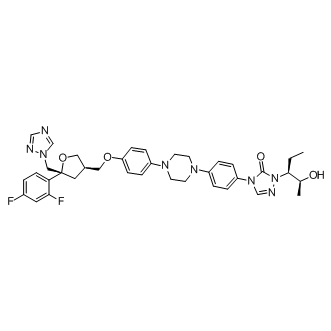
Posaconazole
CAS No. 171228-49-2
Posaconazole( SCH-56592 )
Catalog No. M12610 CAS No. 171228-49-2
A triazole antifungal agent that blocks the synthesis of ergosterol by inhibiting of the enzyme lanosterol 14α-demethylase and accumulation of methylated sterol precursors.
Purity : >98% (HPLC)
 COA
COA
 Datasheet
Datasheet
 HNMR
HNMR
 HPLC
HPLC
 MSDS
MSDS
 Handing Instructions
Handing Instructions
| Size | Price / USD | Stock | Quantity |
| 2MG | 34 | In Stock |


|
| 5MG | 55 | In Stock |


|
| 10MG | 88 | In Stock |


|
| 25MG | 160 | In Stock |


|
| 50MG | 208 | In Stock |


|
| 100MG | 372 | In Stock |


|
| 200MG | Get Quote | In Stock |


|
| 500MG | Get Quote | In Stock |


|
| 1G | Get Quote | In Stock |


|
Biological Information
-
Product NamePosaconazole
-
NoteResearch use only, not for human use.
-
Brief DescriptionA triazole antifungal agent that blocks the synthesis of ergosterol by inhibiting of the enzyme lanosterol 14α-demethylase and accumulation of methylated sterol precursors.
-
DescriptionA triazole antifungal agent that blocks the synthesis of ergosterol by inhibiting of the enzyme lanosterol 14α-demethylase and accumulation of methylated sterol precursors, more potent at inhibiting 14α-demethylase than itraconazole.Fungal Infection Approved(In Vitro):Posaconazole has potent trypanocidal activity. Amiodarone acts synergistically with Posaconazole. Posaconazole also affects and disrupts Ca2+ homeostasis in T. cruzi. Posaconazole blocks the biosynthesis of ergosterol, which is essential for parasite survival. Posaconazole has a clear, dose-dependent effect on proliferation of the epimastigote (extracellular) stages, with a minimal inhibitory concentration of 20 nM and an IC50 of 14 nM. Against the clinically relevant intracellular amastigote form of the parasite, Posaconazole is even more potent. Posaconazole has the minimal inhibitory concentration and IC50 values of 3 nM and 0.25 nM. Posaconazole is active against isolates of Candida and Aspergillus spp. that exhibit resistance to Fluconazole, Voriconazole, and Amphotericin B and is much more active than the other triazoles against zygomycetes. (In Vivo):Treatment of infected animals with amiodarone alone reduces parasitemia, increases survival 60 days pi (0% for untreated controls vs 40% for amiodarone-treated animals) and, when given in combination with Posaconazole, delays the development of parasitemia. Coadministration of Posaconazole and Boost Plus increases drug exposure compared to the administration of Posaconazole alone in the fasted state. Food, particularly meals high in fat content, significantly increases Posaconazole bioavailability. Systemic exposure to Posaconazole increases 4- and 2.6-fold when it is consumed with a high-fat and nonfat meal, respectively. Posaconazole and Amiodarone may constitute an effective anti-T. cruzi therapy with low side effect. At twice-daily doses of ≥ 15 mg/kg of body weight, Posaconazole prolongs the survival of the mice and reduces tissue burden.
-
In Vitro——
-
In Vivo——
-
SynonymsSCH-56592
-
PathwayMicrobiology/Virology
-
TargetFungal
-
RecptorOthers
-
Research AreaInfection
-
IndicationFungal Infection
Chemical Information
-
CAS Number171228-49-2
-
Formula Weight700.7774
-
Molecular FormulaC37H42F2N8O4
-
Purity>98% (HPLC)
-
Solubility10 mM in DMSO
-
SMILESO=C1N([C@@H](CC)[C@@H](O)C)N=CN1C2=CC=C(N3CCN(C4=CC=C(OC[C@@H]5CO[C@@](CN6N=CN=C6)(C7=CC=C(F)C=C7F)C5)C=C4)CC3)C=C2
-
Chemical NameD-threo-Pentitol, 2,5-anhydro-1,3,4-trideoxy-2-C-(2,4-difluorophenyl)-4-[[4-[4-[4-[1-[(1S,2S)-1-ethyl-2-hydroxypropyl]-1,5-dihydro-5-oxo-4H-1,2,4-triazol-4-yl]phenyl]-1-piperazinyl]phenoxy]methyl]-1-(1H-1,2,4-triazol-1-yl)-
Shipping & Storage Information
-
Storage(-20℃)
-
ShippingWith Ice Pack
-
Stability≥ 2 years
Reference
molnova catalog



related products
-
Butenafine hydrochlo...
A synthetic benzylamine antifungal that inhibits the synthesis of ergosterol by inhibiting squalene epoxidase.
-
VT-1598
VT-1598 is a potent, high-affinity, oral inhibitor of fungal sterol 14α-demethylase (CYP51B) with Kd of 13 nM.
-
Caspofungin acetate
A lipopeptide antifungal agent that works by inhibiting the enzyme 1,3-beta-glucan synthase and thereby disturbing the integrity of the fungal cell wall.



 Cart
Cart
 sales@molnova.com
sales@molnova.com


